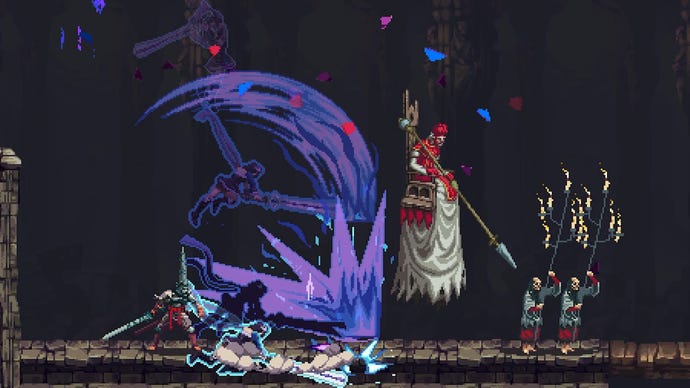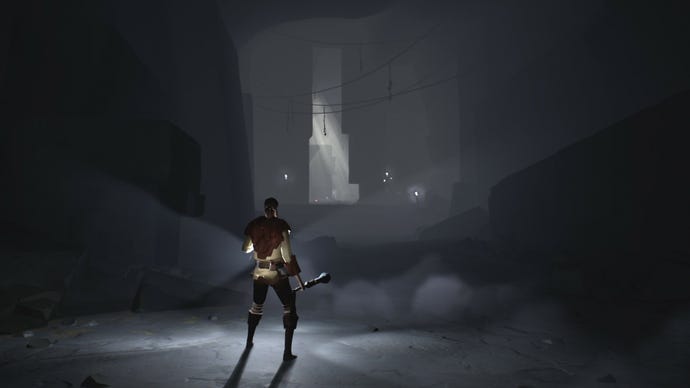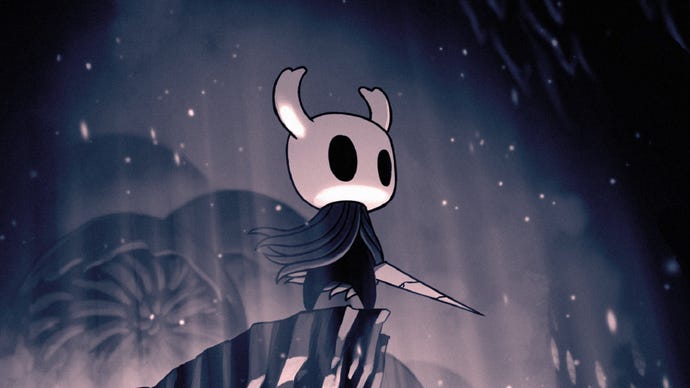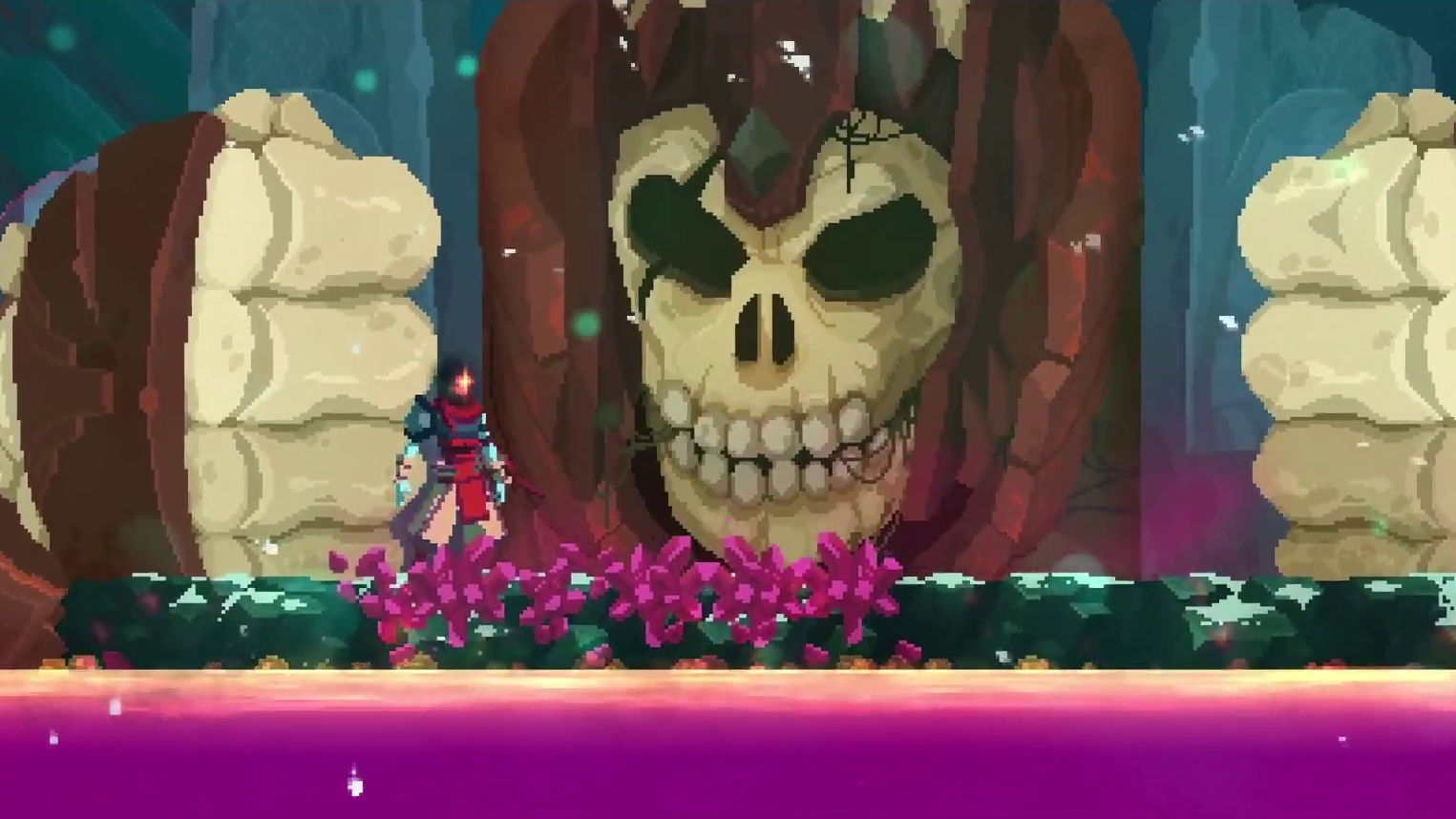The 10 best games like Dark Souls
In honour of His Souliness
Sorry, definition nerds. “Soulslike” is a word now. Disgusting, I know, but this is how genres are made. Along comes a giant like Dark Souls that everybody won’t stop bleating about and soon it has copycats. Before you know it, a swarm of games like Dark Souls with sparse checkpoints and lethal attacks are scuttling around, leaving slime trails and biting your ankles for surprisingly massive damage. Ugh, soulslikes. But stoop low to appreciate these little monsters, and among them you’ll find some very good games about dying.
The 10 Best games like Dark Souls
- Death's Door
- Outward
- Mortal Shell
- Blasphemous
- Ashen
- Nioh 2
- The Surge 2
- Sekiro
- Dead Cells
- Hollow Knight
I’m not here to define the prerequisites of the genre or discuss whether it should even exist. I just want to pick a few of the wondrous horrors off the ground and put ‘em in a big terrarium with reinforced glass, so you can appreciate them. If it helps, think of them not as “soulslikes” but as curious offspring you might like if you enjoyed big daddy souls. Read on to discover more.
We're obviously leaving out the Dark Souls series itself. After all, you can't be "like" the thing you are. Also, Bloodborne is still nowhere to be seen on PC, so obviously don't expect that bad boy to show up. And like most of our lists, the game you like is number 11. Anyway, let's get on with it:
10. Death's Door

Alright, so Death's Door may lack the difficulty of a certain game that rhymes with Bark Mouls, and it may share more in common with Hyrule, than say, Lordran, but hey - it's a good game. And it's a good game about being a crow who loves to fight bosses and dig up secrets. All of which are glossed with smooth surfaces that make the little details pop.
Unlike some of the other games on this list, Death's Door is a light-hearted affair which might comes as a surprise given it's soulsy look. Don't let this put you off, though, as Brendy said that this "lightness suits the game much better" in his Death's Door review.
9. Outward

This big fantasy dander 'em up has some familiar foe-circling combat, putting it firmly with other bruisers about getting knocked out by a monster in a few hits and waking up more furious every time. But in this offering, you awake not at your last campfire or sparkly shrine, but in a random place in the massive open world, after having your pockets picked clean by some opportunistic git.
If Dark Souls is a game about navigating a claustrophobic labyrinth of a dead kingdom while trying not to get cursed by burping frogs, Outward is an adventure about orienteering across open fields full of vicious wolves and trying not to catch the flu on your way to the next town.
It borrows from survival games and open world RPGs as much as it takes from the souls school. You drink tea to cure diseases. You boil water to make it drinkable. And your inventory has to be carefully managed. All that makes the journey more challenging and meaningful. You have a big backpack (your dearest possession) and will need to take that off to become more nimble in a fight. But you’ll also want to keep track of where you put it down, lest you realise mid-fight that all your stamina potions are still in the bag, not your pocket. Whoops. In summary, Outward wants you to leave home and become an independent traveller. Unless, of course, you’re playing in co-op. At which point it becomes a daft journey about shouting down a dungeon corridor at your pal to stop walking into spike traps, for heaven’s sake. We’ve only got two bandages left.
8. Mortal Shell

Mortal Shell sees you play as a Gollum-y figure that can inhabit four Shells that'll drastically alter your playstyle. Spend more time with each set of armour and you'll gradually learn more about them, unlocking new lore snippets and abilities for use in battle. Yes, they're a bit typical: tank take damage, mage finicky, rogue roly-poly, but it's a neat idea.
And the combat's far from perfect, but it's wonderfully weighty as you swing hammers or bring swords down on weird and wonderful enemies. The main highlight, though? The hardening system which sees you character turn to stone at the press of a button. Time it right and an enemy's swing will positively bounce off you, leaving them vulnerable to attack; or just saving your skin in an intense boss battle.
Mortal Shell can be a frustrating experience at times, as you can probably tell from my Mortal Shell review, but it's filled with new, interesting ideas and a world that's quite pretty if you can navigate it. Your mileage might vary, but it's well worth a go if you've got the cash spare.
7. Blasphemous

If you thought it was not possible for a souls ‘em up to be more bloodlustily Catholic than the grand cathedrals and demon deacons of Dark Souls 3, you were mistaken. In Blasphemous you prostrate yourself on the 2D pixel stonework between swinging your thorny sword at baddies in search of penitence (you become penitent by killing all the things, duh).
It’s a grounded metroidvania full to the chalice brim of religious iconography and hard-hitting enemies. You slice holy men in floating chairs, slash self-flagellating whipfellas, and fell sad tree beasts. And all that soulsian lingo we’re used to has a gory Christian twist. Beating a boss is a “Humiliation of Penance”. Passive bonuses like better defence are granted through Rosary beads you find along the way, and new fighting moves (a powerful slice, a ranged attack) are unlocked with this game’s version of a death currency, called “Tears of Atonement”.
You might have to ignore the voice actors who pronounce things like “pious” questionably (it's definitely not “pee-us”, folks). But it handles well and feels good in the old soulfingers. Parrying is nice and generous and you can clasp onto missed ledges automatically. Plus it runs so hard with its theme that you’ve got to admire its blood-soaked vestments. It feels like a bitterly lapsed Roman Catholic and ardent metal fan travelled back in time and made a soulsy game in the era of pixel Castlevania.
6. Ashen

Ashen is a lighter, softer souls, but it retains just enough of that toughness you probably like. Veterans of Undead Burg will drop in comfortably. This soulchild hugs FromSoft’s skirt so close it’s hard to spot its face among the folds. That might be because it doesn’t have a face. The characters in Ashen have fluffy moustaches and hair, but no eyes or mouth.
Nevertheless, these whimsical villagers will join you as an NPC on your journey across the landscape to protect a light-bringing god from an ancient evil. Occasionally that NPC will start acting weird. That’s because a real player is controlling them now. Surprise!
There’s no summoning ritual or faffing with soapstones, the game just throws people together in pairs without so much as a blink. And it works. When your new pal is a decent, helpful adventurer it feels like meeting a new friend by a stroke of luck. You can help each other up ledges and enter special two-player dungeons. In a lot of ways this is the most gentle sorta-souls on this list. There is a map, there are recognisable RPG quests, and the presence of a constant pal (computer-controlled or otherwise) makes your adventure across dark lands less foreboding. There is also a constantly growing village and some wonderful local wildlife, including a big flying animal that looks like a friendly sky whale. If the Buddha were a mythical creature, he’d be this thing.
5. Nioh 2

God, I've spent hours slicing through Sengoku Japan in Nioh 2. If the original Nioh had abs, then this sequel (that's also a prequel) has abs and pecs and a fetching new pair of tabi that deliver decent stat boosts. Like I said in my Nioh 2 review, This is a beefier offering, just with more murderous missions to tick off and delicious loot to consume. The level select screen returns, as do the spiky-shouldered demons and corrupted yokai slabbered in blood.
Thankfully, many more ways exist to smush them to a pulp, like clawed fists or a staff that turns you into a walking blender. One of the great joys of Nioh 2 is the combat, which is tough as nails, but incredibly rich once you get used to the rhythm of your chosen weapon. There are dozens of combos to learn, and skill trees to pour points into, all of which make your samurai "well cool", basically.
The game also showers you in loot which can be broken down into upgrade parts, or popped on for all-important battle bonuses. In many ways, it shares its DNA with Diablo as much as it does Dark Souls, so if you're prepared to dig into its finicky systems and get your calculator out, this is as rewarding a souls experience as you can get.
4. The Surge 2

Some of these games have so much in common with their shared ancestor, you can see the Capra Demon looming over them when you squint. When Deck13 made Lords Of The Fallen the studio was criticised for slicing a little too close to the soul. Their sci-fi follow-up The Surge also kept the soul monies and tough bosses, but it experimented admirably with new angles. You could chop off limbs, for example, and plug in implants for special RPG-style bonuses. But they kept the most important thing from the soul catalogue. The shortcuts.
So when The Surge 2 came out, with it’s choppy-limb combat much improved and grim cyberpunk city of overlapping disaster zones, it was a delight to see that shortcut mentality ramped up to ridiculous levels. The city is a concrete warren of magnetic lifts and secret doorways. Even at the tail end of the game you’ll be finding new pathways back to the starting area, and the metroidvanian accrual of helpful new devices only expands the map you draw inside your head. At one point an electric drone upgrade lets you unlock previously sealed doors, and later a flashy hook lets you ride the locked-off ziplines you’ve been gazing at in anticipation for twenty hours. It’s lattice-like level design more pleasing than a hot cross bun. Deck13’s games still fight in the cold shadow of the Capra Demon. But they innately understand the reassuring warmth of Firelink Shrine. And that’s great.
3. Sekiro: Shadows Die Twice

Hang on! That’s cheating! Oh, I see. It doesn’t have “Souls” in the title. Sekiro is a souls game only insofar as it is made by FromSoftware. And even though it includes basically everything that makes those masochistic adventures worthwhile, it still gets a place on this list for being significantly different.
For example, the multiplayer bits of the soulsies are nowhere to be seen in this trip to a warring Edo Japan. You can’t summon pals or get invaded by nasty men with giant hammers. On top of that, the classic RPG levelling screens are replaced by a cleaner skill tree, which unlocks special abilities for a bony prosthetic ninja arm (eg. a giant steel umbrella, a gun that shoots money). Hell, you don’t even get to equip a new sword, you only use the blade you’re given at the start.
But what a blade. The fighting in Sekiro is eerily satisfying. Full of parries and leaps and backstabs and twirls, the duels against spear-wielding generals and kimono-wearing samurai masters are far more refined than any simple mace fest in Drangleic and far more brutal. Enemies demand so much discipline, timing and restraint, they may as well be screaming “not my tempo” at you between slashes. And there are some bosses that will make you go absolutely ape (massive spoilers, don’t click that, fool).
2. Dead Cells
Genre is stupid, we've established that. When 2D slashfest Dead Cells was first fired down the game tubes at us it was described as a “roguevania” which is almost as disgusting as “soulslike”. But here we are, in a list article about soulslikes, admitting that this fiery little monster of a game is somehow all the genres. It’s fantasy, it’s action, it’s soulsy, it’s a metroidvania, it’s a roguelikelike. Honestly, some games are just greedy.
Greedy for FUN, that is. Dead Cells is a quick sprint through a bright, blood-spattered land full of kamikaze bats and giant lamprey slugs that poop exploding eggs when they die. But instead of intricately designed walkways, this goes for randomly generated warpaths, creating new levels with every death, full of different weapons to find and skills to equip. One run sees you whipping everything in the back of the head and throwing daggers at distant pirates, until you die from an errant cannonball. The next sees you slapping away rapier strikes with a shield and throwing down flamethrower turrets to watch your back. It’s a speedy slicer of constant change. In souls games, you often get fixated on one character build that works. But in this dungeonworld you’ve got to dodge-roll with the punches, and carefully choose among the tools you’re given to make something work. Oh look, a “cursed" sword. I wonder what it does.
1. Hollow Knight

Hollow Knight is big. Bigger than that giant spider on your neck. You play a buggy cartographer, mapping the netherlands beneath a gloomy village of fellow insects (and you’re not the only one). You scuttle downward, nail in hand, slicing at baddies until you hit the first real boss. An absolute scumbag with a mace bigger than your head, and a lethal bum slam to go with it. Finally, you crack open his carapace with the meagre movements currently at your disposal - a jump button and a slash. But this is only the tip of the termite mound. Here’s a map of the first area. And here’s a map of the full game. It isn’t long before you realise, this is a platformer bout terra incognita, about filling blank space with knowledge.
Your journey through the subterranean landscape of Hallownest has all the established quirks of this filthy newborn soulgenre. When you die, you drop a bunch of deathcash, and have to return to the point of doom to retrieve it (the twist here is that you have to kill a little ghost to get it back). It’s got tough-as-jerky bosses, and punishing rooms full of cheeky invertebrates. And it has that characteristically obtuse storytelling, delivered with some classic cryptosouls lore peppering. A chuckling miner sings a song and chips away at rock as you pass, ancient signs tell of a desolated undercity, and a map-obsessed explorer says hello time and again, as you travel in eerie parallel. These characters and discoveries explain piecemeal things about the glum arthropod world, but a full picture isn’t exactly forthcoming. Imagine if Tim Burton had written a script for Antz, but David Lynch was hired to direct and 90% of the sense was left to rust on post-production hard drives.
So yes, Hollow Knight conforms to all the dogma of His Souliness. But then it stuffs all that into the twitchy jaws of a Castlevania-style action platformer, where you unlock new powers to reveal new areas. A glowbug companion who can light your way through a blackout cavern, a ground-slam that breaks through loose stones. And while that secret-hiding stonework might be shaky, everything else is rock soild. You’ve got your precision platforming controls, your floaty jump that lets you about-face in mid-air, your clingy wall-hopping. It’s all here, resulting in some positively Meat Boy moments as you bound through caves full of spikes and shifting walls.







